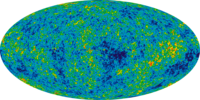
Photo from wikipedia
Asymmetric dark matter (ADM) is motivated by the similar cosmological mass densities measured for ordinary and dark matter. We present a comprehensive theory for ADM that addresses the mass density… Click to show full abstract
Asymmetric dark matter (ADM) is motivated by the similar cosmological mass densities measured for ordinary and dark matter. We present a comprehensive theory for ADM that addresses the mass density similarity, going beyond the usual ADM explanations of similar number densities. It features an explicit matter-antimatter asymmetry generation mechanism, has one fully worked out thermal history and suggestions for other possibilities, and meets all phenomenological, cosmological and astrophysical constraints. Importantly, it incorporates a deep reason for why the dark matter mass scale is related to the proton mass, a key consideration in ADM models. Our starting point is the idea of mirror matter, which offers an explanation for dark matter by duplicating the standard model with a dark sector related by a ${Z}_{2}$ parity symmetry. However, the dark sector need not manifest as a symmetric copy of the standard model in the present day. By utilizing the mechanism of ``asymmetric symmetry breaking'' with two Higgs doublets in each sector, we develop a model of ADM where the mirror symmetry is spontaneously broken, leading to an electroweak scale in the dark sector that is significantly larger than that of the visible sector. The weak sensitivity of the ordinary and dark QCD confinement scales to their respective electroweak scales leads to the necessary connection between the dark matter and proton masses. The dark matter is composed of either dark neutrons or a mixture of dark neutrons and metastable dark hydrogen atoms. Lepton asymmetries are generated by the $CP$-violating decays of heavy Majorana neutrinos in both sectors. These are then converted by sphaleron processes to produce the observed ratio of visible to dark matter in the universe. The dynamics responsible for the kinetic decoupling of the two sectors emerges as an important issue that we only partially solve.
Journal Title: Physical Review D
Year Published: 2018
Link to full text (if available)
Share on Social Media: Sign Up to like & get
recommendations!